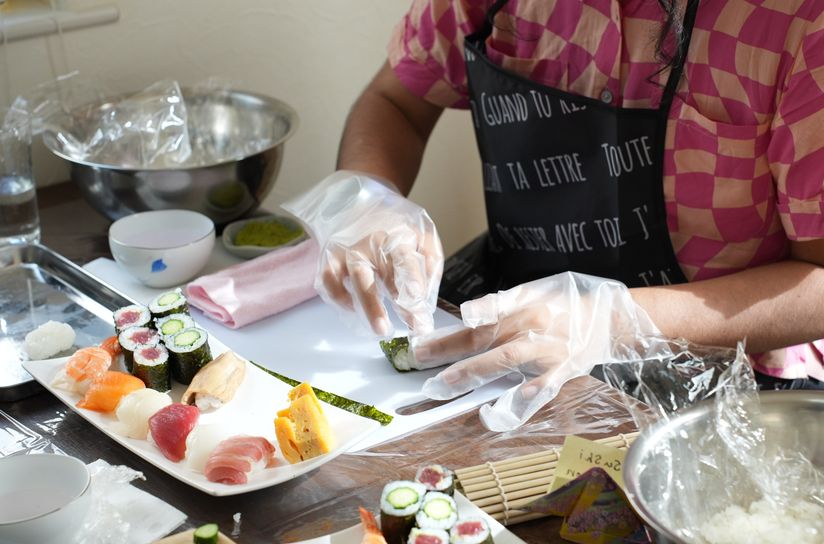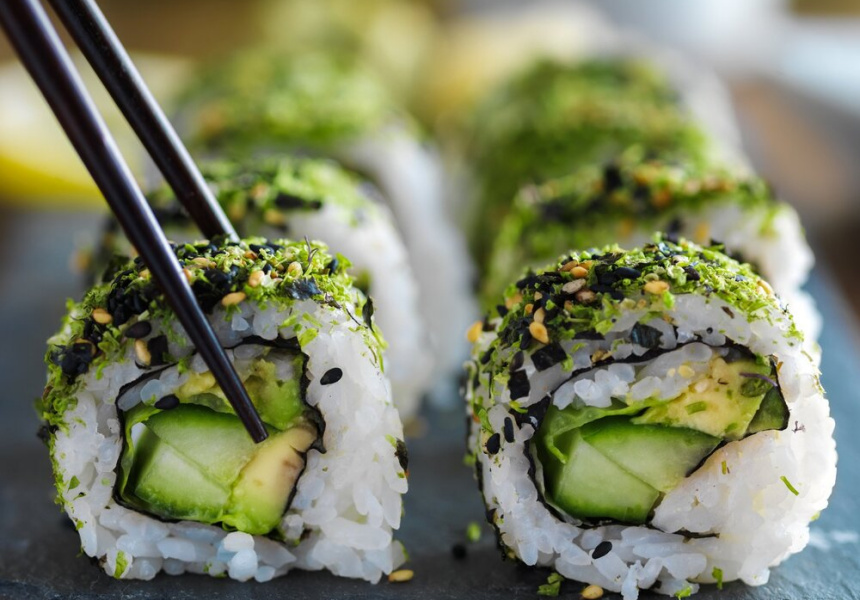A Taste of Japan: Your Guide to Authentic Sushi
Oct 18, 2024 | By Piz za
Japan is a country renowned for its rich culinary heritage, and sushi stands out as one of its most iconic and beloved dishes. This traditional Japanese food, which has taken the world by storm, varies significantly in taste and preparation across the different regions of Japan. From the Edomae sushi of Tokyo to the fresh seafood of Hokkaido, each locale offers a unique sushi experience that is deeply rooted in the area’s history and culture.
The Regional Varieties of Sushi
:max_bytes(150000):strip_icc()/what-is-sushi-5079606-hero-01-e5a0a26f194a49478f84e04193baaefa.jpg)
Sushi in Japan is not a monolith but a mosaic of regional specialties that reflect the local flavors and ingredients. Tokyo is famous for its Edomae sushi, which is characterized by its use of fresh, local seafood from the Tokyo Bay area. The term “Edomae,” which means “in front of Edo,” refers to the old name for Tokyo and the traditional style of sushi that developed there during the Edo period. This style often involves marinating or lightly cooking the seafood to enhance its flavor (Japan-Food.Guide).
Osaka offers a different take on sushi with its pressed sushi, known as “oshi-zushi,” which is typically made by pressing rice and toppings in a mold. Kyoto, on the other hand, is known for its mackerel sushi, a testament to the city’s inland location and the need for preserved fish. Hokkaido, with its cold waters, is renowned for its fresh and high-quality seafood, making it a sushi lover’s paradise. The Seto Inland Sea in Hyogo also boasts its own delicacies, offering sushi made from its rich variety of sea life.
The First Sushi Experience

For those new to sushi, the experience can be both intriguing and overwhelming. The taste of sushi is often described as a harmonious blend of the subtle flavors of the fish with the tangy taste of the vinegared rice. Authentic sushi focuses on the quality of its ingredients and the skill of the sushi chef, known as “itamae.” The itamae’s expertise is evident in their snappy, precise movements, a performance that adds to the overall dining experience (Storia-Japan).
Preparing Sushi at Home

The art of sushi-making can also be brought into the home kitchen. The process involves cooking sushi rice, preparing the fillings, and assembling the rolls. Inarizushi, or sushi wrapped in fried tofu pouches, is a unique and flavorful variation that is relatively easy to prepare. For those seeking to make sushi at home, it is crucial to choose the right ingredients, from the nori seaweed to the sushi rice, to ensure the best taste and texture (WhySoJapan).
Vegan Sushi Options

Sushi is often associated with raw fish, but there are also vegan options available. Cucumber rolls (kappa maki) and fermented soybean rolls (natto maki) are just a few examples of how sushi can be enjoyed by those following a plant-based diet. These options highlight the versatility of sushi and its ability to cater to different dietary preferences (JapanSwitch).
Sushi Etiquette and Accompaniments

Sushi etiquette is an important aspect of the dining experience. Strong fragrances, smoking, and other odors can detract from the taste of sushi, so it is advisable to avoid these when planning to eat sushi. Accompaniments such as green tea, known as “agari,” play a crucial role in enhancing the sushi experience by cleansing the palate between bites (SavorJapan).
Notable Sushi Destinations in Japan
Japan offers a vast array of sushi experiences, with each region boasting its own specialties. For travelers seeking to indulge in authentic sushi, visiting the following locations will provide a deep dive into the diverse flavors and traditions that make sushi a culinary masterpiece.
1. Tokyo – Edomae Sushi:
Known for its fresh seafood sourced from the Tokyo Bay, Tokyo is the birthplace of Edomae sushi. This style is iconic, blending simplicity with exceptional quality. Visiting a sushi bar in Tsukiji or Ginza will give you a taste of sushi’s origins.
2. Osaka – Oshi-zushi (Pressed Sushi):
In Osaka, sushi takes a different form with oshi-zushi, a pressed variety that is tightly packed and rich in flavor. Exploring the Dotonbori area is perfect for trying this distinctive style.
3. Hokkaido – Fresh Seafood Sushi:
Hokkaido, famed for its cold waters, offers some of the freshest seafood in Japan. From salmon to sea urchin, the sushi in Hokkaido is a seafood lover’s paradise. Sapporo and Otaru are particularly well-known for their high-quality sushi restaurants.
4. Kyoto – Mackerel Sushi (Saba-zushi):
Kyoto’s inland location led to the development of preserved fish sushi, with mackerel sushi (saba-zushi) being the most famous. Nishiki Market is a great place to try this traditional sushi.
5. Fukuoka – Mentaiko Sushi:
In southern Japan, Fukuoka’s sushi is highlighted by its use of mentaiko (spicy cod roe), which gives the sushi a unique and bold flavor. This region offers a slightly spicier take on sushi, reflecting its regional preferences.
6. Hyogo – Sushi of the Seto Inland Sea:
The Seto Inland Sea, with its rich marine life, provides a variety of seafood that enhances the sushi offerings in Hyogo. Kobe is the main hub for sampling this local fare.
Exploring these sushi destinations across Japan will not only satisfy your culinary cravings but also allow you to experience the regional diversity and history that have shaped Japan’s sushi culture. Each bite tells a story of the land and the sea, making your sushi journey a memorable part of your travels in Japan.
Conclusion
In conclusion, sushi is not just a dish but a culinary journey that reflects Japan’s diverse regions and their unique flavors. Whether it is the classic Edomae sushi of Tokyo, the pressed sushi of Osaka, or the innovative vegan options, sushi offers something for everyone. The experience of sushi is also enriched by the skill and artistry of the itamae and the customs that accompany this historic cuisine. For anyone looking to explore the authentic taste of Japan, sushi is an essential and unforgettable part of the country’s gastronomic landscape.
Related Blogs

India vs New Zealand: A Traveler’s Perspective on Two Unique Destinations
India vs New Zealand are two destinations that offer contrasting yet equally mesmerizing experiences. India vs New Zealand comparisons often highlight India’s centuries-old traditions, bustling bazaars, and architectural marvels versus New Zealand’s breathtaking natural landscapes and adrenaline-pumping adventures. Whether you’re a culture enthusiast, nature lover, or thrill-seeker, this guide will help you explore the best […]

Barbastro Barcelona: A Journey Through Spain’s Hidden Gems
Spain is a treasure trove of culture, history, and breathtaking landscapes. Two destinations that encapsulate the country’s charm are Barbastro Barcelona. While Barcelona is renowned for its vibrant city life and iconic architecture, Barbastro offers a quieter, more traditional Spanish experience nestled in the heart of the Somontano wine region. Together, they create the perfect […]

The Complete Guide to the Carry On Cast: Past, Present, and Future
The Carry On films stand as a cornerstone of British cinema, delivering decades of laughter and unforgettable characters. This iconic comedy franchise, spanning over 30 years, combined slapstick humor, clever wordplay, and a talented ensemble cast that became household names. This guide explores the history of the Carry On cast, their contributions to the franchise, […]

Exploring Austria’s Iconic Opera Houses
Austria, a nation steeped in a rich cultural heritage, stands as a beacon of classical music and artistic excellence. Among its most revered cultural institutions are its opera houses, which serve as both architectural marvels and stages for world-class performances. This report delves into the history, architecture, notable performances, and cultural significance of Austria’s iconic […]

Exploring the Distinctive Andean Music of Bolivia
The Andean music of Bolivia is a vibrant and integral part of the country’s cultural tapestry, deeply rooted in the traditions and spiritual practices of the Andean peoples. This genre of music is not only a form of artistic expression but also a medium through which the stories, legends, and historical narratives of the Aymara […]

Learning About the Carnival Culture in Rio de Janeiro, Brazil
The Rio de Janeiro Carnival, often heralded as the world’s largest and most famous carnival celebration, is a vibrant showcase of Brazilian culture, history, and community spirit. This annual event, which draws millions of participants and spectators from around the globe, is a testament to Brazil’s rich cultural heritage and its capacity for joyous celebration. […]

Mastering Mozzarella: A Taste of Italy
Mozzarella, a semi-soft cheese originating from Italy, is cherished for its creamy texture and mild flavor. Traditionally crafted from buffalo milk, it also finds a popular variant made from cow’s milk. This cheese is not just a culinary staple but a cultural icon, deeply embedded in Italian society and cuisine. Its high moisture content contributes […]

Discovering the Art of Calligraphy in South Korea
Korean calligraphy, known as “Seoye” (서예), stands as a testament to the rich cultural heritage and artistic expression of Korea. This ancient art form, which involves the artistic writing of both Hanja (Chinese logographs) and Hangul (the Korean native alphabet), transcends mere communication to become a profound medium of aesthetic and spiritual expression. As we […]

Scotland’s Tartan: A History of Highland Dress
Tartan, with its vibrant patterns and historical richness, is one of Scotland’s most iconic symbols. It is inextricably linked to the kilt and the national dress of Scotland, embodying both cultural heritage and identity. This detailed report delves into the origins, evolution, and cultural significance of tartan and Highland dress, exploring how this textile has […]

Tribal Arts of Papua New Guinea: A Unique Heritage
Papua New Guinea (PNG) is a nation marked by its remarkable cultural diversity, with over 800 distinct tribes, each possessing its own language and customs. This diversity is vividly expressed through the tribal arts, which are not only a testament to the rich heritage of the indigenous people but also serve as a living tapestry […]

